不同林龄橡胶(Hevea brasiliensis)林土壤微生物群落和磷组分的变化
2018-01-04任常琦王进闯程汉亭邹雨坤李勤奋
任常琦,王进闯, 程汉亭,邹雨坤,李勤奋
1 海南大学热带农林学院, 海口 570228 2 中国热带农业科学院环境与植物保护研究所, 海口 571101 3 农业部儋州农业环境科学观测实验站, 儋州 571737
不同林龄橡胶(Heveabrasiliensis)林土壤微生物群落和磷组分的变化
任常琦1,2,王进闯2,3,*, 程汉亭2,3,邹雨坤2,3,李勤奋2,3
1 海南大学热带农林学院, 海口 570228 2 中国热带农业科学院环境与植物保护研究所, 海口 571101 3 农业部儋州农业环境科学观测实验站, 儋州 571737
橡胶林是我国热带地区重要的经济林,而土壤磷是热带地区植物生长的重要限制因子之一,理解土壤磷转化机理对于生态系统的磷管理和可持续发展具有重要意义。因此,以热带地区海南儋州不同林龄(4、15、31a)橡胶人工林为研究对象,采用Hedley连续浸提法研究了土壤磷组分,磷脂脂肪酸法(Phospholipid fatty acids,PLFAs)分析了土壤微生物群落。结果表明,在橡胶林内各磷组分的相对含量大小顺序为:闭蓄态磷>中等活性态磷>活性态磷>团聚体内磷>钙磷。随着林龄的增加,橡胶林土壤中的磷组分发生显著变化。4、15、31a橡胶林的闭蓄态磷分别占总提取磷的52.61%、47.17%和34.91%,而活性态磷分别占总提取磷的6.67%、11.32%、13.68%。土壤总微生物、细菌、革兰氏阴性菌(G-)、革兰氏阳性菌(G+)的PLFAs含量均表现为15a>4a>31a,而31a橡胶林放线菌、真菌(F)和丛枝菌根真菌(AMF)的PLFAs含量均低于4a和15a。冗余分析(RDA)显示,全氮、有机碳、pH、F、AMF、G-、G+是引起不同林龄橡胶林土壤磷组分变化的重要贡献因子。研究表明,在橡胶林发育过程中,土壤理化性质和微生物群落发生了明显的变化,进而影响到土壤磷的转化过程。
林龄; 橡胶林; 磷组分; 微生物群落
磷是植物生长发育必不可少的营养元素[1]。在热带地区,由于土壤偏酸性且风化程度高,高含量的铁、铝氧化物对可溶性磷的固定能力强,导致磷有效性低,因此,磷被认为是植物生长的重要限制因子之一[2]。磷通过复杂的生物地球化学过程,以多种形态存在于土壤固液两相中,这些不同形态磷的相互转化影响着土壤磷素的生物有效性[3]。植物可直接吸收土壤溶液中的无机磷酸盐,而不能直接利用磷酸铁铝和闭蓄态磷[4]。因此,深入研究土壤磷含量及其组分变化对于提高土壤磷的有效性有重要的科学意义。
土壤各组分磷含量不仅受到土壤理化性质的影响,还与土壤微生物群落结构和功能密切相关[5]。例如,土壤酸化促使土壤溶液中的无机磷迅速被铁铝吸附,转化成团聚体内磷或闭蓄态磷[6],从而降低土壤磷的有效性。细菌、真菌和丛枝菌根真菌分泌的胞外磷酸酶,可分解有机磷化合物,释放出磷酸盐[7],提高土壤磷的有效性。因此,土壤理化性质和微生物群落在土壤磷转化过程中起着重要作用。
橡胶树(Heveabrasiliensis)是我国热带地区的主要经济树种,橡胶树的种植不但关系到热区农民的收入,更关系到我国国防安全和工业建设。我国自20世纪50年代初开始大面积种植橡胶树,已形成不同林龄胶园1.04×106hm2[8]。长期单一的橡胶林种植造成了胶园土壤养分失衡[9],全磷、有效磷含量显著降低[10- 11],以及丛枝菌根真菌多样性降低等土壤问题[12]。林龄会改变土壤理化性质、酶活性以及微生物群落结构,因此,不同林龄的橡胶林土壤中磷的转化过程可能也存在差异。
目前,关于橡胶林土壤磷素已开展了一些研究,但多集中于幼林和成熟林中全磷和有效磷的含量、分布以及磷循环特征等领域[11,13],缺乏对橡胶林种植全过程中,土壤磷组分动态变化及磷组分与微生物交互关系的清楚认识,特别是对弃割后橡胶林的关注更是少之又少。当橡胶林失去产量后,将近2/3的橡胶林被放弃。这些被放弃的橡胶林对土壤微生物的资源供给发生了变化[14],将会对土壤磷的转化产生深刻影响,进而影响到后续土地的利用[15]。理解弃割后橡胶林的土壤磷组分动态变化对未来橡胶林地的合理利用具有重要意义。
因此,本文以4a(幼龄)、15a(成龄)和31a(弃割)的橡胶人工林为研究对象,采用Hedley连续浸提法研究了土壤磷组分,磷脂脂肪酸法(Phospholipid fatty acids,PLFAs)分析了土壤微生物群落。目的在于:(1)明确橡胶林在不同生长阶段土壤磷组分的动态变化;(2)探讨土壤磷组分与土壤理化性质、微生物群落之间的相互关系,阐明土壤磷转化的机理。以期为橡胶人工林的磷肥管理提供理论支撑。
1 材料与方法
1.1 试验区概况
试验设在中国热带农业科学院试验场(19°32′47″N,109°28′30″E)内。地势平缓,土壤为花岗岩砖红壤。该地区属热带季风性气候,光热资源充足,全年日照约2100h,年平均气温23.5℃。雨水丰沛,年平均降雨量1607mm。干、湿季节明显,雨量主要集中在5月至10月,11月至翌年4月降水较少。
试验区种植橡胶林之前,为立地条件(地势、坡度、土壤环境)基本一致的荒地。4a幼龄林(生长期)和15a成龄林(割胶期)全年施入的氮、磷、钾量分别为76.72、25.18、51.30kg/hm2,其中包括一次有机肥,每株20kg。而31a老龄林弃割1年,弃割后不再进行施肥等管理。林下多为草本植物,如:弓果黍(Cyrtococcumpatens)、假臭草(Praxelisclematidea)、飞机草(Eupatoriumodoratum)、肖梵天(Urenalobata)、奥图草(Ottochloa)、地胆头(Elephantopusscaber)等。
1.2 样品采集
于2015年11月中旬,选取4、15、31a的3个林龄的橡胶人工林,每个林龄的橡胶林随机设置3个10m×10m的样方,在每个样方内采用梅花形布点法采集0—20cm土壤,均匀混合作为1个土壤样品。因此,每个林龄有3个重复。将每份土样分成两部分,一部分保存在-80℃,用于微生物磷脂脂肪酸的测定。另一部分经自然风干,过2mm筛,用于土壤理化性质和酸性磷酸酶活性的测定,过0.149mm筛用于土壤磷组分测定。
1.3 分析项目及测定方法
1.3.1 土壤理化性质
采用电位法(水土比2.5∶1)测定土壤pH值[16];TOC分析仪法测定有机碳含量[17];H2SO4-HClO4-钼锑抗比色法测定全磷含量[18];半微量开氏法测定全氮含量[18];靛酚蓝比色法测定铵态氮含量[18];紫外分光光度法测定硝态氮含量[19]。
1.3.2 土壤磷组分

1.3.3 土壤微生物指标
以KOH-甲醇溶液甲酯化法提取磷脂脂肪酸[22],十九烷酸为内标,采用G1701EA GC-MS检测。方法如下:进样口温度为280℃,分流比为20∶1,柱温以70℃为起始程序升温,保持1min,以20℃/min升温至170℃,保持2min,再以5℃/min升温至280℃,保持5min,最后以40℃/min升温至300℃,保持1.5min[23]。不同的磷脂脂肪酸标记特定的微生物,14:00、15:00、17:00、i14:0、i15:0、a15:0、i16:0、i17:0、a17:0、16:1w7c、18:1w5c、cy17、cy19标记细菌[24],i14:0、i15:0、a15:0、i16:0、i17:0、a17:0标记革兰氏阳性菌,16:1w7c、18:1w5c、cy17、cy19标记革兰氏阴性菌[25]。18:2w6c、18:1w9c标记真菌,16:1w5c标记丛枝菌根真菌[26]。16:0 10-methyl、17:0 10-methyl、18:0 10-methyl标记放线菌[27]。
土壤微生物量磷采用氯仿熏蒸、0.5mol/L NaHCO3(pH 8.5)以1∶4土水比浸提30min,另做未熏蒸对照,测定全磷增量即为微生物量磷[28]。
土壤酸性磷酸酶活性采用磷酸苯二钠比色法测定[29]。
1.4 数据处理
以SPSS 19.0对土壤理化性质、磷组分、微生物PLFAs进行单因素方差分析(oneway ANOVA)和最小显著差异法(Least significant differences,LSD)比较不同林龄间的差异性,通过Person相关性分析评价理化性质和微生物PLFAs之间的相关关系;以Canoco 4.5进行冗余分析(Redundancy Analysis,RDA)确定土壤磷组分和微生物群落变化的主要影响因子。相关图表制作在Origin 8.1和Excel 2007中完成。
2 结果与分析
2.1 不同林龄橡胶林土壤理化性质变化
4a橡胶林土壤pH值显著高于15a和31a,而15a橡胶林土壤有机碳含量显著高于4a和31a(表1)。全氮含量在15a橡胶林土壤中最高,其次是4a,31a最低。随着林龄的增加,土壤无机氮和铵态氮含量显著降低(P<0.05)而C/N显著增加(P<0.05)。4a和15a的土壤N/Po明显高于31a(P<0.05)(表1)。

表1 不同林龄橡胶林土壤理化性质
Po:有机磷 Organic phosphorus;同列不同小写字母代表差异显著(P<0.05)
2.2 不同林龄橡胶林土壤微生物PLFAs、微生物量磷和酸性磷酸酶活性变化
土壤微生物PLFAs和群落结构在不同林龄间发生显著性变化(P<0.05)。土壤总微生物、细菌、革兰氏阴性菌(G-)、革兰氏阳性菌(G+)的PLFAs含量均表现为15a>4a>31a。31a橡胶林土壤放线菌、真菌和丛枝菌根真菌(AMF)的PLFAs含量均显著低于4a和15a(P<0.05)。4a胶林土壤F/B值显著高于15a(P<0.05)。G-/G+在不同林龄间无显著性差异(P>0.05)(表2)。土壤微生物量磷含量在15a胶林土壤中显著高于4a(P<0.05)(图1)。不同林龄间,酸性磷酸酶活性差异不显著(P>0.05)(图2)。
同行不同小写字母代表差异显著(P<0.05)
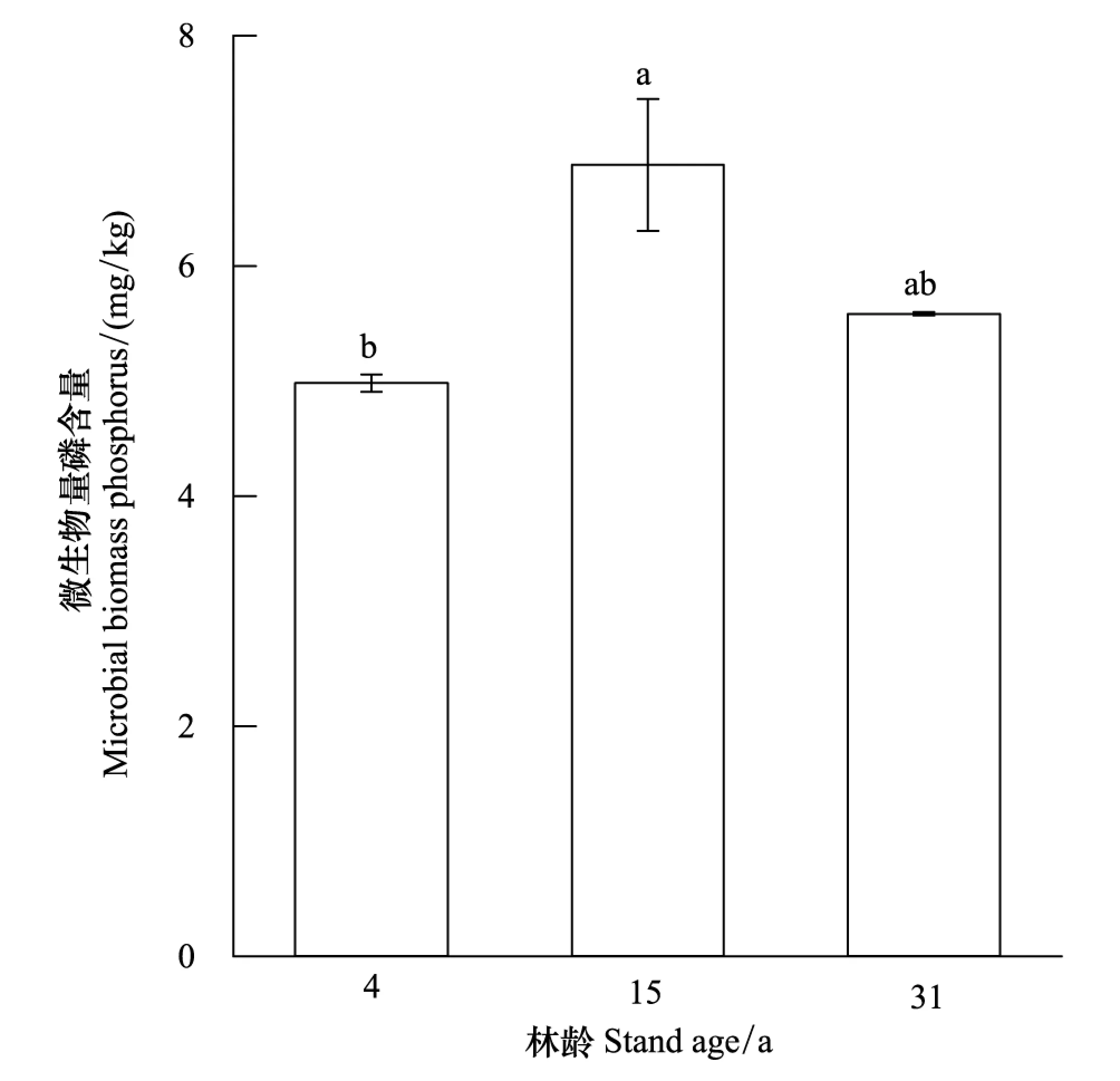
图1 不同林龄橡胶林土壤微生物量磷含量 Fig.1 Microbial biomass phosphorus in soil of rubber rubber plantations at different stand ages
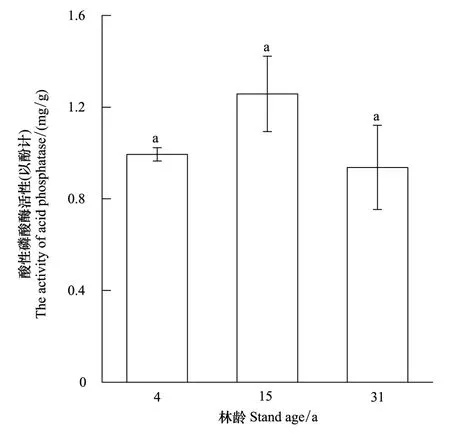
图2 不同林龄橡胶林土壤酸性磷酸酶活性 Fig.2 The activity of acid phosphatase in soil of plantations at different stand ages
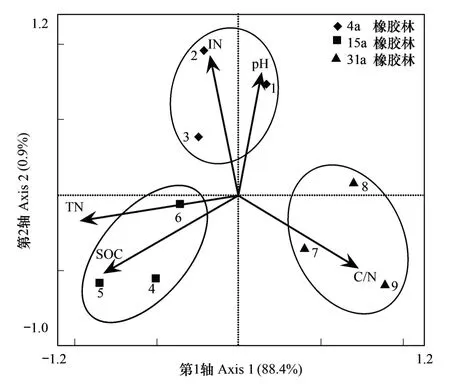
图3 不同林龄橡胶林土壤理化性质与微生物群落结构RDA分析Fig.3 Redundancy analysis on the physicochemical properties and soil microbial communities TN:全氮 Total nitrogen;IN:无机氮 Inorganic nitrogen;SOC:有机碳 Soil organic carbon
2.3 土壤微生物群落与理化性质冗余分析及相关性分析
不同林龄橡胶林土壤理化性质和微生物群落的冗余分析(RDA)结果显示,环境数据解释了土壤微生物群落变异的89.3%。其中,第一轴解释了总变异的88.4%,第二轴解释总变异的0.9%。微生物群落在不同林龄间明显分离,说明全氮、有机碳、C/N是微生物群落变化的主要影响因子(图3)。
相关性分析结果显示,土壤全氮与G-、G+、细菌、放线菌极显著正相关,与AMF显著正相关。无机氮与F/B呈极显著正相关,与真菌显著正相关。有机碳与G-、G+、细菌显著正相关。pH与F/B显著正相关。C/N与G+、细菌、放线菌显著负相关,与真菌极显著负相关(表3)。
2.4 不同林龄橡胶林土壤全磷和磷组分变化
土壤全磷含量在不同林龄橡胶林间差异显著(P<0.05),其含量随林龄的增加逐渐降低,表现为4a>15a>31a(图4a)。
活性态磷和中等活性态磷含量在15a橡胶林土壤中最高,其次是31a,4a最低,而钙磷含量在15a橡胶林土壤中最低,4a和31a差异不显著(P>0.05)。团聚体内磷含量在15a橡胶林土壤中最高,其次是4a,而31a最低。闭蓄态磷含量在4a和15a差异不显著(P>0.05),在31a橡胶林土壤中显著降低(P<0.05)(图4)。土壤磷组分的相对含量表现为闭蓄态磷>中等活性态磷>活性态磷>团聚体内磷>钙磷,闭蓄态磷和中等活性态磷是土壤磷组分的主要部分,二者之和占总提取磷的73.7%—82.2%(图5)。

表3 土壤理化性质与微生物PLFAs相关性分析
*P<0.05,**P<0.01
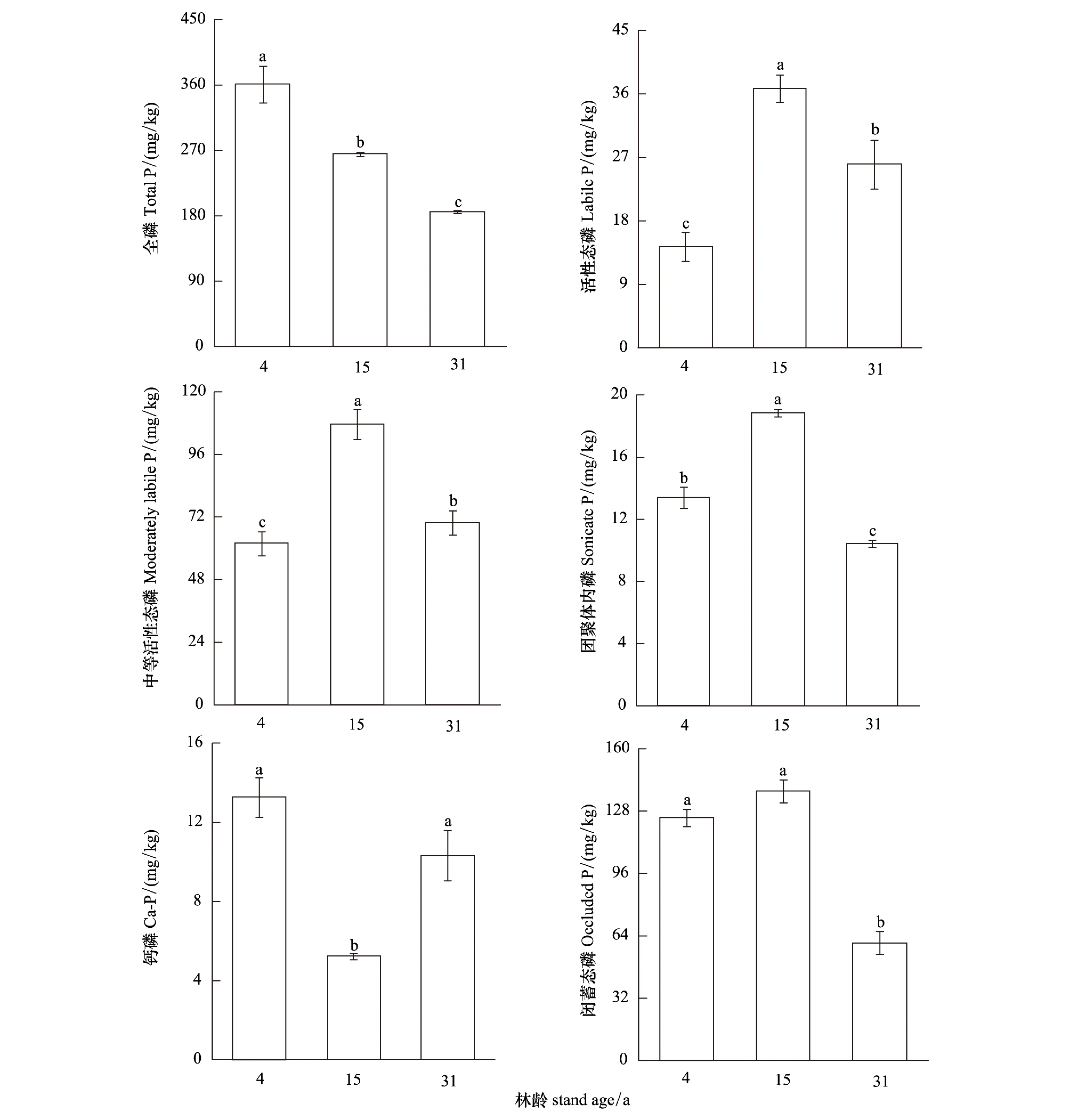
图4 不同林龄橡胶林土壤磷含量Fig.4 Phosphorus in soil of rubber plantations at different stand ages
2.5 磷组分间相关性分析
磷组分间的相关性可表征不同磷组分间的转化关系。中等活性态磷与活性态磷极显著正相关,与团聚体内磷显著正相关。团聚体内磷与闭蓄态磷极显著正相关(表4)。

表4 磷组分间相关性分析
*P<0.05,**P<0.01
2.6 磷组分与土壤理化性质、微生物群落的冗余分析
不同林龄橡胶林土壤磷组分与土壤理化性质、微生物群落冗余分析(RDA)结果显示,环境数据解释了土壤磷组分变异的98.9%,其中,第一轴解释了总变异的81.6%,第二轴解释总变异的17.3%。土壤磷组分在不同林龄橡胶林间明显分离,说明土壤理化性质、微生物群落的变化,导致了不同林龄橡胶林土壤磷组分变化。其中,pH与Ca-P的相关性较高,有机碳与活性态磷、中等活性态磷具有较高的相关性,而真菌、丛枝菌根真菌、放线菌与闭蓄态磷的相关性较高(图6)。
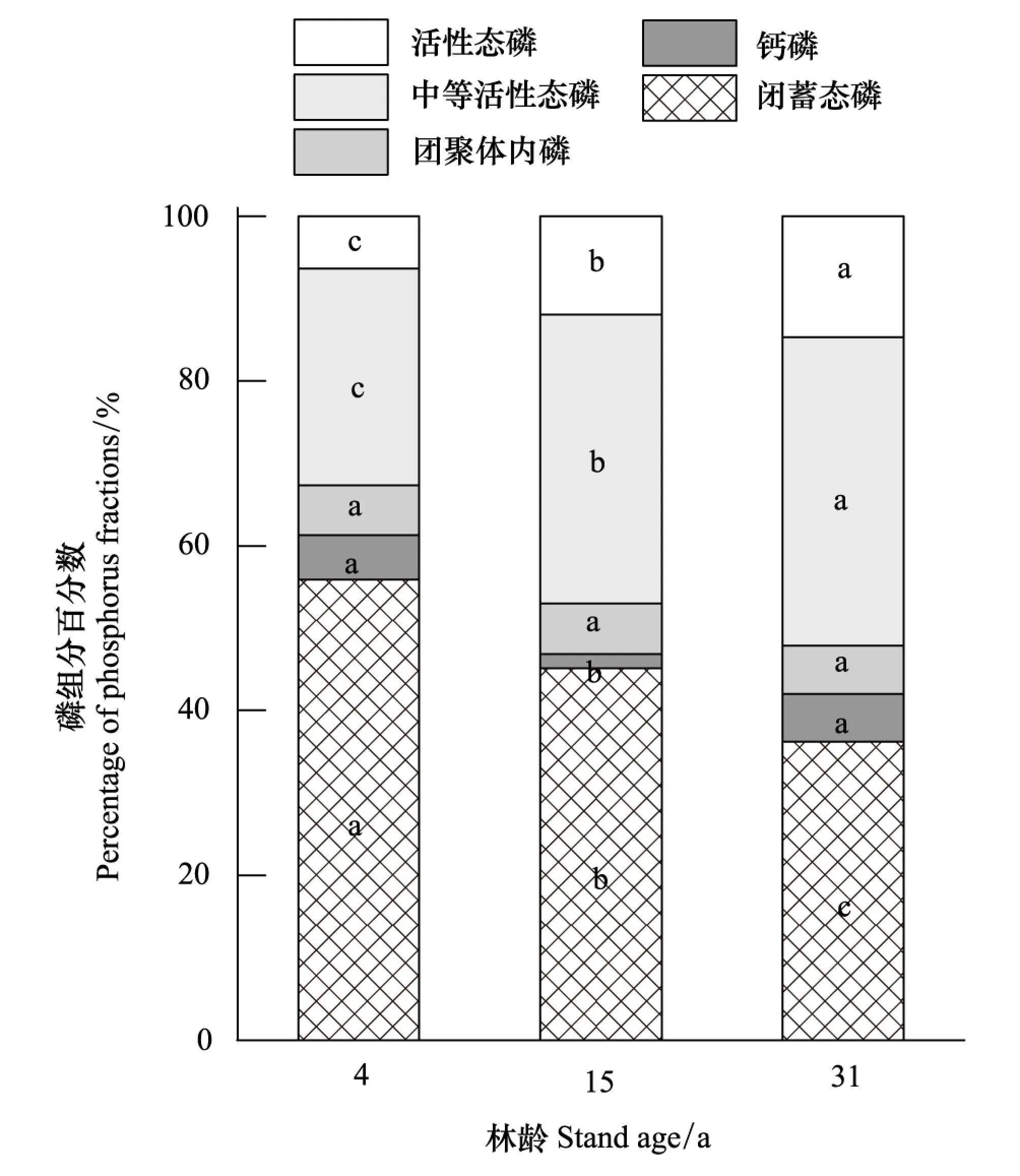
图5 不同林龄橡胶林土壤各形态磷百分数 Fig.5 Soil phosphorus fractions for different age rubber plantations as a percentage of total P相同磷组分中不同小写字母代表不同林龄间差异显著(P<0.05)
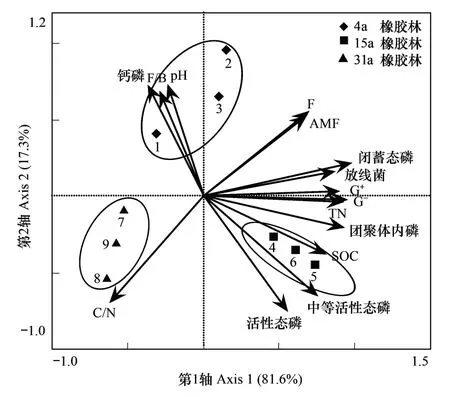
图6 不同林龄橡胶林土壤理化性质、微生物群落结构与磷组分的冗余分析Fig.6 Redundancy analysis on the soil microbial and physicochemical properties and soil phosphorus fractionsTN:全氮 Total nitrogen;SOC:有机碳 Soil organic carbon;G+:革兰氏阳性细菌 Gram-positive bacteria;G-:革兰氏阴性细菌 Gram-negative bacteria;AMF:丛枝菌根真菌 Arbuscular mycorrhizal Fungi;F:真菌Fungi;F/B:真菌/细菌 Fungi/Bacteria
3 讨论
3.1 不同林龄橡胶林土壤微生物群落的变化
土壤微生物PLFAs总量与细菌PLFAs含量均表现为15a>4a>31a(表2)。这可能与各林龄阶段橡胶树向土壤输送的碳、氮含量[9,30]密切相关。不同林龄下的根系分泌物和凋落物改变了地上和地下的碳输入,这可能会影响土壤微生物PLFAs含量和组成[31]。成龄林生长旺盛、根系发达,根系分泌物和地表凋落物更多,因此,归还土壤的碳含量为微生物提供更多的可利用碳源。而幼龄林,根系还不发达,分泌物和凋落物比成龄林少,碳归还量降低[32],有限的可利用碳源可能减少了微生物PLFAs含量。弃割林生长衰退,根系老化[33]且凋落物减少,这很可能减少碳的地下输入量,限制微生物生长。另外,施肥可能增加了土壤有机质含量,利于维持较高的土壤微生物活性,形成相对稳定的微生物多样性特征组分[34]。RDA分析结果显示,有机碳和总氮对微生物群落的影响最大(图3)。由此可见,微生物PLFAs总量和细菌PLFAs含量主要受土壤有机碳、氮含量影响。
真菌PLFAs含量表现为31a橡胶林土壤显著低于4a和15a(表2),而真菌PLFAs与C/N呈极显著负相关,而与无机氮呈显著正相关(表3)。这说明土壤氮的水平影响着真菌PLFAs含量。31a胶林土壤C/N较高,而氮素含量极低,可能是氮素供应不足限制了真菌生长。相似地,牛小云等[35]研究表明,在落叶松土壤中,较高的C/N和氮素供应不足将显著抑制真菌的生长。此外,真菌在热带酸性土中是主要的分解者[14],其生物量可能也会受到土壤有机质含量的影响。31a胶林土壤,有机质含量降低,引起真菌可利用碳源减少,这可能使真菌PLFAs含量降低[34]。F/B通常用来估计细菌和真菌的相对丰度,15a橡胶林土壤F/B值显著低于4a(P<0.05),说明细菌群落在15a橡胶林土壤中更占优势,这也表明15a胶林地下养分周转更快。
G-和G+的PLFAs含量均表现为15a>4a>31a,这可能与不同林龄橡胶林向土壤中释放的碳、氮含量有关。同时,有机肥的输入也可能增加了G-和G+可利用的碳源[34]。G-/G+在不同林龄间无明显变化,比值为0.4(表2),说明在各林龄胶林的土壤中,G+占主导地位,而G+是寡营养型微生物[36]。这些结果表明,在橡胶人工林中,土壤养分较为贫瘠[37]。AMF的PLFAs含量在31a橡胶林土壤中显著低于4a和15a。这与Chakraborty等[38]对印度东北部不同林龄橡胶林土壤中AMF的研究结果一致。这可能与有限的资源分配和生物间的交互作用有关[39]。植物根系释放的光合作用碳的含量会影响土壤微生物的数量和活性[3]。31a橡胶林根系活力减弱,根系分泌物减少,减少了碳的地下输入量,AMF生长所需的碳源含量降低,可能引起AMF含量降低。
3.2 不同林龄橡胶林土壤磷组分的变化
由RDA分析可知,不同林龄的橡胶林具有不同的磷组分特征(图6)。RDA分析显示,F、AMF、G+、G-等生物因素和pH、TN、TOC、C/N等非生物因素是导致不同林龄土壤磷组分变化的主要驱动因子。这也证明磷的转化过程是土壤理化性质和微生物共同作用的结果[4]。这可能是橡胶林在不同林龄阶段,向地下输入的碳、氮含量不同,引起细菌、真菌、丛枝菌根真菌群落的改变,影响了土壤磷组分的形态和含量[40-41]。
随着林龄的增加,橡胶林土壤全磷含量逐渐减少(P<0.05)(图4)。而随着橡胶树的生长,橡胶树从土壤中吸收大量的磷,导致全磷含量降低[11]。另外,橡胶树割胶也可能带走了一部分土壤磷[42]。
活性态磷含量在15a橡胶林土壤中最高,其次是31a,而4a最低(图4)。在高度风化的酸性土壤中,有机磷的矿化是活性态磷的重要来源[43-44]。N/Po在高度风化的热带土壤中可以反映有机磷的矿化率,N/Po越大,表明矿化率越高,无机磷释放越多,活性态磷含量也就越高[45]。15a橡胶林土壤N/Po值显著高于31a(表1),这可能是由于成龄橡胶林根系发达,微生物量也达到最高水平(表2),微生物对有机磷的矿化能力加强[46],矿化释放的无机磷增加了活性态磷含量。可是,研究也发现,4a橡胶林的N/Po值高于31a,活性态磷含量却低于31a。这可能是因为4a橡胶树虽然有很强的矿化能力,但是幼龄橡胶树对养分需求大[12],可能吸收了大量的活性态磷。Schrijver等[43]研究也表明,橡树(QuercusroburL.)对活性态磷的吸收会导致其含量降低。上述结果表明,活性态磷含量不但与有机磷矿化有关,还受到根系吸收的影响。

团聚体内磷含量表现为15a>4a>31a(图4)。这可能与微生物作用以及土壤pH有关。4a和15a胶林土壤丛枝菌根真菌含量较高,有利于团聚体的形成[49],可能增加了团聚体内磷含量。另外,当pH在3.2—5.5范围内变化时,随pH降低,团聚体对磷的吸附量也会增加[50]。
Ca-P含量在15a橡胶林土壤中显著低于4a和31a(图4),这可能与细菌和真菌的溶磷作用有关。15a胶林土壤细菌、真菌PLFAs含量较高(表2),一些细菌和真菌代谢过程中产生CO2或H+,使土壤溶液的酸度提高,促进Ca-P溶解[46],导致Ca-P含量降低。而4a和31a橡胶林土壤细菌、真菌含量较低,对Ca-P溶解能力减弱[51]。
橡胶林种植31a后,闭蓄态磷含量显著降低(图4)。前人研究多认为,闭蓄态磷可作为磷源被利用而导致其含量降低。例如,张教林等[52]研究表明,橡胶林吸收的磷有52%来自于闭蓄态磷的矿化,种植34a后的橡胶林,闭蓄态磷含量显著降低。Chen等[53]研究表明,在不同林龄落叶松人工林土壤中,与铁、铝结合的闭蓄态磷可作为磷源被利用,使成龄林土壤中闭蓄态磷含量显著低于幼龄和近成熟林。而本研究中,闭蓄态磷含量在31a胶林土壤中显著降低,但其原因可能不是被橡胶树利用,可能是真菌和丛枝菌根真菌含量较低,对磷的矿化能力下降[46,54],减少了土壤矿物可固定的无机磷含量,导致闭蓄态磷含量降低[4]。Zhang等[5]研究也表明,真菌加强了有机磷的矿化,释放的无机磷被可交换态锰沉淀下来形成闭蓄态磷。在森林发展的后期,闭蓄态磷含量降低。上述结果表明,稳定态磷的转化不仅与土壤微生物作用密切相关,同时也受到土壤性质的影响。
4 结论
本研究表明,橡胶林长期单一种植下,磷组分和微生物群落结构发生较大变化。随着林龄的增加,橡胶林土壤的微生物群落多样性,磷循环转化能力呈现出先增加后减少的趋势。成龄橡胶林土壤微生物PLFAs含量、活性态磷组分和稳定态磷组分(团聚体内磷、闭蓄态磷)含量较幼龄林土壤显著增加,而弃割后,橡胶林土壤微生物群落PLFAs含量和稳定态磷组分含量显著降低。其中细菌、真菌、AMF对稳定态磷组分的矿化是加速土壤磷转化的重要生物因素,而pH、TN、TOC也与此密切相关。因此,在探讨橡胶林土壤中磷的转化过程时,应充分考虑微生物群落和土壤理化性质的重要作用。
[1] Egle L, Zoboli O, Thaler S, Rechberger H, Zessner M. The Austrian P budget as a basis for resource optimization. Resources, Conservation and Recycling, 2014, 83: 152- 162.
[2] de Oliveira C M B, Erich M S, Gatiboni L C, Ohno T. Phosphorus fractions and organic matter chemistry under different land use on Humic Cambisols in Southern Brazil. Geoderma Regional, 2015, 5: 140- 149.
[3] Richardson A E, Simpson R J. Soil microorganisms mediating phosphorus availability update on microbial phosphorus. Plant Physiology, 2011, 156(3): 989- 996.
[4] Yang X, Post W M. Phosphorus transformations as a function of pedogenesis: a synthesis of soil phosphorus data using Hedley fractionation method. Biogeosciences, 2011, 8(10): 2907- 2916.
[5] Zhang H Z, Shi L L, Wen D Z, Yu K L. Soil potential labile but not occluded phosphorus forms increase with forest succession. Biology and Fertility of Soils, 2016, 52(1): 41- 51.
[6] Olander L P, Vitousek P M. Biological and geochemical sinks for phosphorus in soil from a wet tropical forest. Ecosystems, 2004, 7(4): 404- 419.
[7] Godin A M, Lidher K K, Whites M D, Jones M D. Control of soil phosphatase activities at millimeter scales in a mixed paper birch-Douglas-fir forest: the importance of carbon and nitrogen. Soil Biology and Biochemistry, 2015, 80: 62- 69.
[8] Li S N, Zou F S, Zhang Q, Sheldon F H. Species richness and guild composition in rubber plantations compared to secondary forest on Hainan Island, China. Agroforestry Systems, 2013, 87(5): 1117- 1128.
[9] 赵春梅, 蒋菊生, 曹建华, 熊代群, 谢贵水, 李晓波. 橡胶人工林养分循环通量及特征. 生态学报, 2009, 29(7): 3782- 3789.
[10] Maranguit D, Guillaume T, Kuzyakov Y. Land-use change affects phosphorus fractions in highly weathered tropical soils. CATENA, 2017, 149: 385- 393.
[11] 吴志祥, 谢贵水, 杨川, 周兆德, 陈帮乾. 海南岛西部不同林龄橡胶林土壤养分特征. 海南大学学报: 自然科学版, 2011, 29(1): 42- 48.
[12] Herrmann L, Lesueur D, Bräu L, Davison J, Jairus T, Robain H, Robin A, Vasar Mi, Wiriyakitnateekul W, Öpik M. Diversity of root-associated arbuscular mycorrhizal fungal communities in a rubber tree plantation chronosequence in Northeast Thailand. Mycorrhiza, 2016, 26(8): 863- 877.
[13] Moreira A, Moraes L A C, Zaninetti R A. Phosphorus dynamics in the conversion of a secondary forest into a rubber tree plantation in the amazon rainforest. Soil Science, 2013, 178(11): 618- 625.
[14] Nurulita Y, Adetutu E M, Kadali K K, Shahsavari E, Zul D, Taha M, Ball A S. Assessment of the influence of oil palm and rubber plantations in tropical peat swamp soils using microbial diversity and activity analysis. Journal of Agricultural Chemistry and Environment, 2016, 5(2): 53- 65.
[15] Ekukinam E U, Iwara A I, Gani B S. Evaluation of phosphorus and exchangeable bases status of soil under rubber plantation of different ages in south-eastern nigeria. Open Science Journal of Bioscience and Bioengineering, 2014, 1(2): 19- 22.
[16] 鲁如坤. 土壤农业化学分析方法. 北京: 中国农业科技出版社, 2000.
[17] 钱宝, 刘凌, 肖潇. 土壤有机质测定方法对比分析. 河海大学学报: 自然科学版, 2011, 39(1): 34- 38.
[18] 鲍士旦. 土壤农业化学分析(第三版). 北京: 中国农业出版社, 2000.
[19] 宋歌, 孙波, 教剑英. 测定土壤硝态氮的紫外分光光度法与其他方法的比较. 土壤学报, 2007, 44(2): 288- 293.
[20] Hedley M J, Stewart J W B, Chauhan B S. Changes in inorganic and organic soil phosphorus fractions induced by cultivation practices and by laboratory incubations. Soil Science Society of America Journal, 1982, 46(5): 970- 976.
[21] Costa M G, Gama-Rodrigues A C, de Moraes Gonçalves J L, Gama-Rodrigues E F, da Silva Sales M V, Aleixo S. Labile and non-labile fractions of phosphorus and its transformations in soil under eucalyptus plantations, Brazil. Forests, 2016, 7(1): 15.
[22] Frostegård Å, Tunlid A, Bååth E. Use and misuse of PLFA measurements in soils. Soil Biology and Biochemistry, 2011, 43(8): 1621- 1625.
[23] 林生, 庄家强, 陈婷, 张爱加, 周明明, 林文雄. 不同年限茶树根际土壤微生物群落PLFA生物标记多样性分析. 生态学杂志, 2013, 32(1): 64- 71.
[24] Frostegård A, Bååth E. The use of phospholipid fatty acid analysis to estimate bacterial and fungal biomass in soil. Biology and Fertility of Soils, 1996, 22(1/2): 59- 65.
[25] Zelles L. Fatty acid patterns of phospholipids and lipopolysaccharides in the characterisation of microbial communities in soil: a review. Biology and Fertility of Soils, 1999, 29(2): 111- 129.
[26] Kulmatiski A, Beard K H. Long-term plant growth legacies overwhelm short-term plant growth effects on soil microbial community structure. Soil Biology and Biochemistry, 2011, 43(4): 823- 830.
[27] Kroppenstedt R M. The genus nocardiopsis. Procaryotes, 1992, 2: 1139- 1156.
[28] 吴金水, 肖和艾, 陈桂秋, 黄敏. 旱地土壤微生物磷测定方法研究. 土壤学报, 2003, 40(1): 70- 78.
[29] 沈桂琴. 土壤中磷酸酶活性的测定方法. 土壤肥料, 1987, (1): 40- 42.
[30] Yannikos N, Leinweber P, Helgason B L, Baum C, Walley F L, Van Rees K C J. Impact ofPopulustrees on the composition of organic matter and the soil microbial community in Orthic Gray Luvisols in Saskatchewan (Canada). Soil Biology and Biochemistry, 2014, 70: 5- 11.
[31] Feng W T, Zou X M, Schaefer D. Above-and belowground carbon inputs affect seasonal variations of soil microbial biomass in a subtropical monsoon forest of southwest China. Soil Biology and Biochemistry, 2009, 41(5): 978- 983.
[32] Qiu L P, Wei X R, Gao J L, Zhang X C. Dynamics of soil aggregate-associated organic carbon along an afforestation chronosequence. Plant and Soil, 2015, 391(1/2): 237- 251.
[33] 唐建维, 庞家平, 陈明勇, 郭贤明, 曾荣. 西双版纳橡胶林的生物量及其模型. 生态学杂志, 2009, 28(10): 1942- 1948.
[34] 孙锋, 赵灿灿, 何琼杰, 吕会会, 管奕欣, 谷艳芳. 施肥和杂草多样性对土壤微生物群落的影响. 生态学报, 2015, 35(18): 6023- 6031.
[35] 牛小云, 孙晓梅, 陈东升, 张守攻. 辽东山区不同林龄日本落叶松人工林土壤微生物、养分及酶活性. 应用生态学报, 2015, 26(9): 2663- 2672.
[36] Creamer C A, Filley T R, Boutton T W, Rowe H I. Grassland to woodland transitions: dynamic response of microbial community structure and carbon use patterns. Journal of Geophysical Researc: Biogeosciences, 2016, 121(6): 1675- 1688.
[37] Wang J C, Ren C Q, Cheng H T, Zou Y K, Bughio M A, Li Q F. Conversion of rainforest into agroforestry and monoculture plantation in China: consequences for soil phosphorus forms and microbial community. Science of the Total Environment, 2017, 595: 769- 778.
[38] Chakraborty K, Sinha S, Debnath A, Das A R, Saha A K, Das P. Arbuscular mycorrhizal fungal colonization in three different age groups of rubber plantations in Tripura, North-East India. Plant Pathology & Quarantine, 2016, 6(2): 122- 131.
[39] Johnson N C, Angelard C, Sanders I R, Kiers E T. Predicting community and ecosystem outcomes of mycorrhizal responses to global change. Ecology Letters, 2013, 16(1): 140- 153.
[40] Oberson A, Joner E J. Microbial turnover of phosphorus in soil//Turner B L, Frossard E, Baldwin D S, eds. Organic Phosphorus in the Environment. Wallingford: CABI, 2005: 133- 164.
[41] Bünemann E K, Prusisz B, Ehlers K. Characterization of phosphorus forms in soil microorganisms//Bünemann E K, Oberson A, Frossard E, eds. Phosphorus in Action: Biological Processes in Soil Phosphorus Cycling. Berlin Heidelberg: Springer, 2011: 37- 57.
[42] 陈永川, 杨春霞, 李春丽, 汤利. 橡胶林土壤中磷的动态变化特征规律研究. 土壤通报, 2012, 43(5): 1201- 1206.
[43] de Schrijver A, Vesterdal L, Hansen K, De Frenne P, Augusto L, Achat D L, Staelens J, Baeten L, De Keersmaeker L, De Neve S, Verheyen K. Four decades of post-agricultural forest development have caused major redistributions of soil phosphorus fractions. Oecologia, 2012, 169(1): 221- 234.
[44] Wang J P, Wu Y H, Zhou J, Bing H J, Sun H Y. Carbon demand drives microbial mineralization of organic phosphorus during the early stage of soil development. Biology and Fertility of Soils, 2016, 52(6): 825- 839.
[45] McGill W B, Cole C V. Comparative aspects of cycling of organic C, N, S and P through soil organic matter. Geoderma, 1981, 26(4): 267- 286.
[46] Jones D L, Oburger E. Solubilization of phosphorus by soil microorganisms//Bünemann E K, Oberson A, Frossard E, des. Phosphorus in Action: Biological Processes in Soil Phosphorus Cycling. Berlin Heidelberg: Springer, 2011: 169- 198.
[47] Sanchez P A. Properties and management of soils in the tropics. Soil Science, 1977, 124(3): 187.
[48] Rashmi I, Biswas A K, Parama V R R. Phosphorus management in agriculture: a review. Agricultural Reviews, 2014, 35(4): 261- 270.
[49] Li X L, Zhang J L, Gai J P, Christie P, Li X L. Contribution of arbuscular mycorrhizal fungi of sedges to soil aggregation along an altitudinal alpine grassland gradient on the Tibetan Plateau. Environmental Microbiology, 2015, 17(8): 2841- 2857.
[50] 文勤亮, 郭倩楠, 祝媛, 董长勋. 南方酸性土壤团聚体对磷的吸附解吸特征及pH值的影响. 黑龙江大学自然科学学报, 2014, 31(6): 800- 805.
[51] Khan M S, Zaidi A, Wani P A. Role of phosphate-solubilizing microorganisms in sustainable agriculture-a review. Agronomy for Sustainable Development, 2007, 27(1): 29- 43.
[52] 张教林, 陈爱国. 热带胶园土壤磷素形态和生物有效性. 生态环境学报, 1999, 8(4): 284- 286.
[53] Chen L X, Zhang C, Duan W B. Temporal variations in phosphorus fractions and phosphatase activities in rhizosphere and bulk soil during the development ofLarixolgensisplantations. Journal of Plant Nutrition and Soil Science, 2016, 179(1): 67- 77.
[54] Zhang L, Wang M X, Li H, Yuan L, Huang J G, Penfold C. Mobilization of inorganic phosphorus from soils by ectomycorrhizal fungi. Pedosphere, 2014, 24(5): 683- 689.
Effectsofrubber(Heveabrasiliensis)plantationsonsoilphosphorusfractionsandmicrobialcommunitycomposition
REN Changqi1,2, WANG Jinchuang2,3,*, CHENG Hanting2,3, ZOU Yukun2,3, LI Qinfen2,3
1AcademyofTropicalAgricultureandForestry,HainanUniversity,Haikou570228,China2ChineseAcademyofTropicalAgricultureSciencesEnvironmentandPlantProtectionInstitute,Haikou571101,China3AgriculturalEnvironmentalScienceObservationandExperimentStation,MinistryofAgriculture,Danzhou571737,China
Phosphorus (P) is recognized as one of the most limiting nutrients for primary production in tropical forests because much of the soil P stocks are geochemically bound to iron and aluminum oxides in forms that are largely unavailable for plant uptake. The availability of P to microorganisms and plants can be assessed by evaluating different soil P fractions, and soil P occurs in both organic and inorganic forms, which differ in behavior, mobility, and bioavailability (i.e., labile P, moderately labile P, non-labile P). Labile and non-labile P fractions can serve as sources or sinks of available P, and non-labile P can be released into soil solutions as available P through desorption when the content of available P decreases in the soil. Therefore, it is critical to understand the transformation between different soil P fractions when developing best practices for fertilizer management that aim to enhance the P use efficiency of agricultural systems. Soil microorganisms are important mediators of P mineralization and immobilization, owing to their ability to reduce P availability by immobilizing P in their biomass, which subsequently increases stocks of microbial P in the soil. In addition, lower available P content was observed in tropical soil, accompanied by higher soil phosphatase activity. Furthermore, arbuscular mycorrhizal fungi (AMF) can take up P from pools that are normally considered unavailable to plants. However, the relationship between the dynamics of soil P forms, soil properties, and soil microbial communities has yet to be established in rubber plantation at different ages. Therefore, we compared the soil P fractions (i.e., labile P, moderately labile P, sonicate P, Ca-P, and occluded P) and soil microbial community composition of 4-, 15-, and 31-year-old rubber plantations on Hainan Island, Southern China. The aims of this study were (1) to determine whether the soil P stock and fractions would change with increasing plantation age; (2) to test whether the composition of soil microbial communities would change with plantation age; and (3) to quantify the relationships between P fraction, microbial community, and other soil attributes. The results could be used to develop recommended P fertilizer management practices for sustainable rubber plantations. We found that occluded P was the largest phosphorus fraction, followed by moderately labile P, labile P, sonicate P, and Ca-P in all plantations. The levels of bacteria and both gram-positive and gram-negative bacterial Phospholipid fatty acids (PLFAs) were highest in the 15-year-old plantation, whereas the levels of actinomycetes, arbuscular mycorrhizal fungi (16:1ω5c), and fungal PLFAs were lowest in the 31-year-old plantation. The level of soil acid phosphatase activity did not change with increasing plantation age, and redundancy analysis indicated that both biotic and abiotic factors were important contributors to variation in soil P fractions. Accordingly, the present study demonstrates that the age of rubber plantations significantly affects the soil physicochemical properties and microbial communities of rubber plantations and, consequently, soil P availability and cycling.
stand age; rubber plantation; phosphorus fraction; microbial community
国家自然科学基金(31640014); 中央级公益性科研院所基本科研业务费专项(17CXTD-04, 2015hzs1J012); 海南省自然科学基金(317235)
2017- 05- 02;
2017- 08- 15
*通讯作者Corresponding author.E-mail: wangjc@catas.cn
10.5846/stxb201705020803
Ren C Q, Wang J C, Cheng H T, Zou Y K, Li Q F.Effects of rubber (Heveabrasiliensis) plantations on soil phosphorus fractions and microbial community composition.Acta Ecologica Sinica,2017,37(23):7983- 7993.
